Related Research Articles

The Atanasoff–Berry computer (ABC) was the first automatic electronic digital computer. Limited by the technology of the day, and execution, the device has remained somewhat obscure. The ABC's priority is debated among historians of computer technology, because it was neither programmable, nor Turing-complete. Conventionally, the ABC would be considered the first electronic ALU – which is integrated into every modern processor's design.

The history of computing hardware covers the developments from early simple devices to aid calculation to modern day computers.
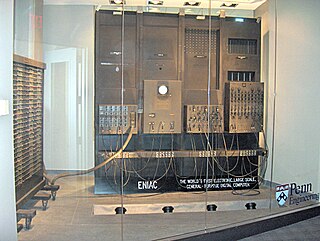
ENIAC was the first programmable, electronic, general-purpose digital computer, completed in 1945. There were other computers that had combinations of these features, but the ENIAC had all of them in one package. It was Turing-complete and able to solve "a large class of numerical problems" through reprogramming.

John Adam Presper Eckert Jr. was an American electrical engineer and computer pioneer. With John Mauchly, he designed the first general-purpose electronic digital computer (ENIAC), presented the first course in computing topics, founded the Eckert–Mauchly Computer Corporation, and designed the first commercial computer in the U.S., the UNIVAC, which incorporated Eckert's invention of the mercury delay-line memory.
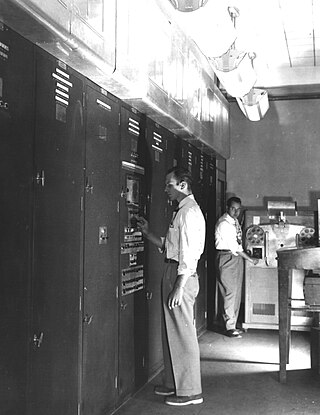
EDVAC was one of the earliest electronic computers. It was built by Moore School of Electrical Engineering, Pennsylvania. Along with ORDVAC, it was a successor to the ENIAC. Unlike ENIAC, it was binary rather than decimal, and was designed to be a stored-program computer.
John William Mauchly was an American physicist who, along with J. Presper Eckert, designed ENIAC, the first general-purpose electronic digital computer, as well as EDVAC, BINAC and UNIVAC I, the first commercial computer made in the United States.

Sir Maurice Vincent Wilkes was a British computer scientist who designed and helped build the Electronic Delay Storage Automatic Calculator (EDSAC), one of the earliest stored program computers, and who invented microprogramming, a method for using stored-program logic to operate the control unit of a central processing unit's circuits. At the time of his death, Wilkes was an Emeritus Professor at the University of Cambridge.
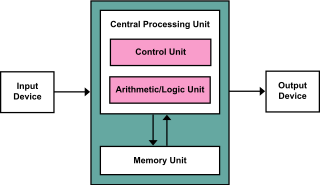
The von Neumann architecture—also known as the von Neumann model or Princeton architecture—is a computer architecture based on a 1945 description by John von Neumann, and by others, in the First Draft of a Report on the EDVAC. The document describes a design architecture for an electronic digital computer with these components:

Herman Heine Goldstine was a mathematician and computer scientist, who worked as the director of the IAS machine at Princeton University's Institute for Advanced Study and helped to develop ENIAC, the first of the modern electronic digital computers. He subsequently worked for many years at IBM as an IBM Fellow, the company's most prestigious technical position.
The First Draft of a Report on the EDVAC is an incomplete 101-page document written by John von Neumann and distributed on June 30, 1945 by Herman Goldstine, security officer on the classified ENIAC project. It contains the first published description of the logical design of a computer using the stored-program concept, which has come to be known as the von Neumann architecture; the name has become controversial due to von Neumann's failure to name other contributors.

Douglas Rayner Hartree was an English mathematician and physicist most famous for the development of numerical analysis and its application to the Hartree–Fock equations of atomic physics and the construction of a differential analyser using Meccano.

The Moore School of Electrical Engineering at the University of Pennsylvania came into existence as a result of an endowment from Alfred Fitler Moore on June 4, 1923. It was granted to Penn's School of Electrical Engineering, located in the Towne Building. The first dean of the Moore School was Harold Pender.
The Eckert–Mauchly Computer Corporation (EMCC) was founded by J. Presper Eckert and John Mauchly. It was incorporated on December 22, 1947. After building the ENIAC at the University of Pennsylvania, Eckert and Mauchly formed EMCC to build new computer designs for commercial and military applications. The company was initially called the Electronic Control Company, changing its name to Eckert–Mauchly Computer Corporation when it was incorporated. In 1950, the company was sold to Remington Rand, which later merged with Sperry Corporation to become Sperry Rand, and survives today as Unisys.

Frances Elizabeth Holberton was an American computer scientist who was one of the six original programmers of the first general-purpose electronic digital computer, ENIAC. The other five ENIAC programmers were Jean Bartik, Ruth Teitelbaum, Kathleen Antonelli, Marlyn Meltzer, and Frances Spence.
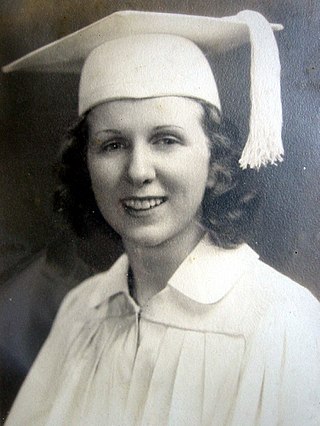
Kathleen Rita Antonelli, known as Kay McNulty, was an Irish-born American computer programmer and one of the six original programmers of the ENIAC, one of the first general-purpose electronic digital computers. The other five ENIAC programmers were Betty Holberton, Ruth Teitelbaum, Frances Spence, Marlyn Meltzer, and Jean Bartik.
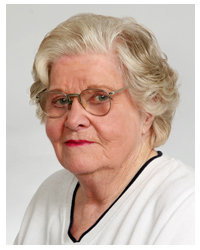
Jean Bartik was one of the original six programmers for the ENIAC computer.
Honeywell, Inc. v. Sperry Rand Corp., et al., 180 U.S.P.Q. 673, was a landmark U.S. federal court case that in October 1973 invalidated the 1964 patent for the ENIAC, the world's first general-purpose electronic digital computer. The decision held, in part, the following: 1. that the ENIAC inventors had derived the subject matter of the electronic digital computer from the Atanasoff–Berry computer (ABC), prototyped in 1939 by John Atanasoff and Clifford Berry, 2. that Atanasoff should have legal recognition as the inventor of the first electronic digital computer and 3. that the invention of the electronic digital computer ought to be placed in the public domain.
Leland Erskin Cunningham was an American astronomer and discoverer of minor planets. In a career spanning 50 years, he became an authority on orbit theory and on precise measurements of the orbits of comets, planets, satellites, and space probes. He was also an early authority on electronic digital computers and assisted in their construction and use in orbit calculations.

Arthur Walter Burks was an American mathematician who worked in the 1940s as a senior engineer on the project that contributed to the design of the ENIAC, the first general-purpose electronic digital computer. Decades later, Burks and his wife Alice Burks outlined their case for the subject matter of the ENIAC having been derived from John Vincent Atanasoff. Burks was also for several decades a faculty member at the University of Michigan in Ann Arbor.

Alice Burks was an American author of children's books and books about the history of electronic computers.
References
- ↑ Verzuh, Frank M. Personal Notes on Moore School Lectures (CBI 51), Charles Babbage Institute, University of Minnesota
- ↑ Oral history interview with James T. Pendergrass, Charles Babbage Institute, University of Minnesota
- ↑ Oral history interview with Cuthbert Corwin Hurd Oral history interview by Robert W. Seidel, 18 November 1994. Charles Babbage Institute, University of Minnesota.
- Campbell-Kelly, Martin; Williams, Michael R., eds. (1985). The Moore School Lectures: Theory and Techniques for Design of Electronic Digital Computers . Cambridge, Massachusetts; London, England; Los Angeles, California; San Francisco, California: The MIT Press and Tomash Publishers. ISBN 0-262-03109-4.
- Wilkes, Maurice V. (1985). Memoirs of a Computer Pioneer. Cambridge, Massachusetts; London, England: The MIT Press. pp. 116–126. ISBN 0-262-23122-0.
- Lukoff, Herman (1979). From Dits to Bits: A personal history of the electronic computer. Portland, Oregon, USA: Robotics Press. pp. 59–60. ISBN 0-89661-002-0. LCCN 79-90567.
- Shurkin, Joel (1996). Engines of the Mind: The Evolution of the Computer from Mainframes to Microprocessors (2 ed.). New York, New York; London, England: W. W. Norton & Company. p. 205. ISBN 0-393-31471-5.